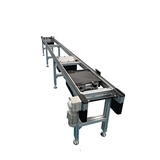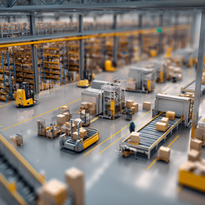Installing a conveyor system in your facility is a significant investment that can greatly enhance your material handling efficiency. Once you have selected the right conveyor system for your needs, it's important to ensure proper installation and setup to maximize its performance. In addition to the basic installation process, there are various accessories and upgrades available that can further enhance the functionality and productivity of your conveyor system. In this article, we will explore the installation and setup process of conveyor systems, as well as discuss some additional accessories and upgrades that you can consider.
Best Practices for Installing Your Conveyor System
Installing a conveyor system is a crucial step in optimizing your material handling processes and improving operational efficiency. Proper installation ensures that the system functions smoothly, operates safely, and meets your specific needs. To help you achieve a successful installation, we have compiled a list of best practices to follow. By adhering to these guidelines, you can maximize the performance and longevity of your conveyor system.
1. Plan and Prepare
Before beginning the installation process, it is essential to plan and prepare thoroughly. Consider the layout of your facility, available space, and the flow of materials. Take accurate measurements and evaluate any potential obstacles or constraints that may impact the installation. Develop a detailed installation plan, including a timeline, necessary equipment, and resources required for the project.
2. Follow the Manufacturer's Guidelines
The manufacturer's guidelines are your roadmap to a successful installation. Familiarize yourself with the manufacturer's installation instructions, specifications, and recommendations. Adhering to these guidelines ensures that the system is installed correctly and operates as intended. Failure to follow the manufacturer's instructions may lead to performance issues, safety hazards, or premature wear and tear.
3. Engage Professional Installation Services
If you lack the expertise or resources to handle the installation in-house, consider engaging professional installation services. Experienced technicians can ensure that the conveyor system is installed correctly and in compliance with industry standards. They have the knowledge, skills, and specialized tools required to handle the installation process efficiently and effectively.
4. Ensure Proper Alignment
Proper alignment is crucial for the smooth operation of your conveyor system. Misalignment can cause belt tracking issues, increased wear on components, and potential product jams or damage. During installation, pay close attention to the alignment of belts, pulleys, rollers, and other components. Use alignment tools and techniques, such as laser alignment or string lines, to ensure that the system is aligned accurately.
5. Check Belt Tension
Proper belt tension is essential for optimal conveyor performance. Insufficient tension can lead to belt slippage, reduced carrying capacity, and premature wear. Conversely, excessive tension can strain the components and increase power consumption. Follow the manufacturer's recommendations for the appropriate belt tension and use tensioning devices or methods to achieve the desired tension level.
6. Conduct Thorough Testing
Once the conveyor system is installed, conduct thorough testing to ensure that it operates smoothly and meets your requirements. Test the system under different load conditions to verify its performance and identify any potential issues. Check for proper belt tracking, alignment, speed control, and responsiveness of the control system. Address any observed deviations or anomalies promptly.
7. Train Operators and Maintenance Staff
Provide comprehensive training to operators and maintenance staff who will be responsible for operating and maintaining the conveyor system. Train them on safe operation practices, emergency procedures, routine maintenance tasks, and troubleshooting techniques. Proper training minimizes the risk of accidents, ensures efficient operation, and prolongs the lifespan of the system.
8. Implement a Preventive Maintenance Program
Establish a preventive maintenance program to proactively address the maintenance needs of your conveyor system. Regular inspections, lubrication, and component replacements based on manufacturer recommendations are essential for keeping the system in optimal condition. Adhere to a maintenance schedule and document all maintenance activities to ensure consistent performance and maximize the lifespan of the equipment.
9. Monitor Performance and Safety
Once the conveyor system is up and running, continuously monitor its performance and safety. Regularly inspect the system for any signs of wear, damage, or abnormal operation. Monitor belt tension, alignment, and tracking to prevent issues before they escalate. Ensure that safety features, such as emergency stop buttons and safety guards, are functioning properly. Encourage operators and staff o report any safety concerns or operational issues immediately. Regularly review performance metrics, such as throughput, downtime, and energy consumption, to identify areas for improvement and optimize system efficiency.
10. Document Installation and Maintenance
Maintain detailed documentation of the installation process, including diagrams, plans, and equipment specifications. This documentation serves as a valuable resource for future reference, troubleshooting, and system modifications. Additionally, keep a record of all maintenance activities, including inspections, repairs, and component replacements. This information helps track the system's performance over time and enables better decision-making regarding future maintenance and upgrades.
Tips for Proper Ventilation and Electrical Requirements of Your Conveyor System
Proper ventilation and electrical requirements are critical considerations when installing a conveyor system. Adequate ventilation helps maintain a safe and comfortable working environment, while meeting electrical requirements ensures the efficient and reliable operation of the system. In this article, we will provide you with some tips to ensure proper ventilation and electrical setup for your conveyor system.
Ventilation Tips
Assess Ventilation Needs: Evaluate the specific ventilation requirements of your conveyor system based on factors such as the type of products being transported, the heat generated by motors or equipment, and any hazardous materials or fumes involved. Consider the local regulations and industry standards regarding ventilation in your facility.
- Provide Adequate Airflow: Ensure that the conveyor system area receives proper airflow to dissipate heat and prevent the buildup of contaminants. Install exhaust fans, ventilation ducts, or air circulation systems as necessary. Consider the placement of these systems to optimize airflow around the conveyor system and adjacent areas.
- Implement Local Exhaust Ventilation: If your conveyor system involves processes that generate dust, fumes, or hazardous materials, implement local exhaust ventilation systems. These systems capture and remove contaminants at the source, protecting workers' health and maintaining air quality. Position exhaust hoods or capture devices strategically along the conveyor system to effectively capture the contaminants.
- Consider Environmental Factors: Take into account the environmental conditions of your facility, such as temperature, humidity, and air quality. Extreme temperatures or high humidity levels can affect the performance of the conveyor system and its components. Consider implementing environmental control measures, such as air conditioning or dehumidification, to maintain optimal operating conditions.
- Regular Maintenance: Maintain a regular maintenance schedule for the ventilation systems to ensure they function effectively. Clean filters, inspect fans for proper operation, and clear any obstructions that may hinder airflow. Regularly monitor the ventilation system to identify and address any issues promptly.
Electrical Requirements Tips
Consult a Qualified Electrician: Engage a qualified electrician or electrical contractor experienced in conveyor system installations. They can assess your facility's electrical infrastructure and provide expert guidance on meeting the electrical requirements of your conveyor system.
- Determine Power Capacity: Determine the power capacity needed to operate your conveyor system. Consider factors such as motor horsepower, voltage requirements, and the overall power consumption of the system. Ensure that your facility's electrical system can handle the anticipated power load without overloading circuits.
- Install Proper Wiring: Follow electrical codes and regulations when installing wiring for the conveyor system. Use appropriate wiring sizes and types to handle the electrical current and prevent overheating or voltage drop. Implement proper grounding to ensure electrical safety.
- Incorporate Emergency Stops: Install emergency stop buttons or switches at strategic locations along the conveyor system. These stops provide a quick and accessible means to shut down the system in case of emergencies or safety concerns. Ensure that emergency stops are clearly marked and easily identifiable.
- Implement Motor Protection: Protect the motors of your conveyor system with appropriate motor protection devices, such as overload relays or circuit breakers. These devices help prevent motor damage due to excessive current or overheating. Ensure that the motor protection devices are correctly sized for the motor's requirements.
- Consider Control Systems: Select control systems that meet your specific needs and comply with electrical safety standards. Implement control panels with appropriate safety features, such as circuit breakers, motor starters, and safety interlocks. Integrate control systems that allow for easy monitoring and troubleshooting of the conveyor system's electrical components.
- Implement Proper Cable Management: Ensure proper cable management to avoid entanglement or damage to electrical cables. Use cable trays, conduits, or cable carriers to organize and protect wiring. Secure cables with appropriate fasteners and ensure they are positioned away from moving parts or areas where they could be pinched or damaged.
Conveyor System Configuration: Tips for Designing and Layout
Designing the layout of your conveyor system is a critical step in optimizing material flow, maximizing efficiency, and ensuring smooth operations. The configuration of your conveyor system determines how materials will be transported, the sequence of operations, and the overall workflow within your facility. In this article, we will provide you with some valuable tips for designing and laying out your conveyor system to achieve the best possible configuration.
1. Evaluate Material Flow and Process Requirements
Before designing the layout, evaluate the material flow and process requirements of your facility. Understand how materials move through your production or distribution processes and identify key process points, such as loading, sorting, assembly, and packaging. Consider factors such as product dimensions, weight, and handling requirements. This analysis will help you determine the optimal conveyor system configuration that meets your specific needs.
2. Consider Space Availability and Constraints
Assess the available space in your facility and identify any constraints or obstacles that may impact the layout of your conveyor system. Consider factors such as existing machinery, columns, walls, and storage areas. Measure the dimensions of the space accurately to ensure that the conveyor system can be installed without hindering other operations. Work closely with facility planners, architects, and conveyor system experts to optimize the use of available space.
3. Optimize Material Flow and Efficiency
Design the conveyor system layout to optimize material flow and minimize handling time. Consider the sequence of operations and arrange the conveyors in a logical order to facilitate a smooth and efficient workflow. Minimize unnecessary stops, transfers, and manual handling. Incorporate features such as merging, diverting, and accumulation zones strategically to streamline material flow and reduce bottlenecks.
4. Determine Conveyor Types and Configurations
Select the appropriate conveyor types and configurations based on your specific requirements. Common conveyor types include belt conveyors, roller conveyors, chain conveyors, and overhead conveyors. Each type has its advantages and is suitable for specific applications. Determine the optimal combination of conveyor types and configurations that will effectively move materials through your processes while considering factors such as product characteristics, production volume, and space availability.
5. Consider Ergonomics and Worker Safety
Prioritize ergonomics and worker safety in the design of your conveyor system layout. Ensure that the conveyor heights, access points, and workstations are ergonomically designed to minimize strain and fatigue for operators. Incorporate safety features such as safety guards, emergency stop buttons, and warning signs to prevent accidents and ensure compliance with safety regulations. Involve your workforce in the design process to gather their insights and address any concerns they may have.
6. Plan for Maintenance and Service Accessibility
Account for maintenance and service accessibility when designing the layout of your conveyor system. Plan for easy access to critical components, such as motors, drives, and bearings, to facilitate regular inspections and maintenance tasks. Consider the clearance requirements for maintenance personnel and equipment, and ensure that there is sufficient space for repairs or component replacements without disrupting other operations.
7. Utilize Software Tools and Simulation
Take advantage of software tools and simulation techniques to aid in the design and layout process. Conveyor system design software can help you visualize different layout options, simulate material flow, and optimize the configuration based on your specific requirements. These tools can provide valuable insights into potential bottlenecks, optimize conveyor lengths and speeds, and ensure efficient use of available space.
Common Installation and Setup Mistakes to Avoid
Proper installation and setup of a conveyor system are crucial for its efficient operation and longevity. However, there are common mistakes that can compromise the performance and safety of the system. By being aware of these mistakes, you can take proactive measures to avoid them. In this article, we will highlight some common installation and setup mistakes to help you ensure a successful conveyor system implementation.
1. Inadequate Planning and Preparation
One of the most significant mistakes is a lack of proper planning and preparation. Failing to conduct a thorough assessment of your facility, including space constraints, material flow requirements, and equipment compatibility, can lead to inefficient system design and layout. Take the time to plan and prepare adequately before installing the conveyor system. This includes evaluating space availability, identifying potential obstacles, and considering the specific needs of your operations.
2. Ignoring Manufacturer's Guidelines
Each conveyor system comes with manufacturer's guidelines and installation instructions. Neglecting to follow these guidelines can result in serious issues. Manufacturers provide specific instructions for a reason – to ensure the system functions properly and safely. Disregarding these guidelines may lead to premature wear and tear, increased maintenance requirements, and safety hazards. Always refer to the manufacturer's instructions and adhere to their recommendations during installation and setup.
3. Poor Alignment and Belt Tension
Improper alignment and inadequate belt tension are common mistakes that can affect the performance and lifespan of your conveyor system. Misalignment can cause belt tracking issues, increased wear on components, and product damage. Insufficient or excessive belt tension can result in slippage, reduced carrying capacity, and increased power consumption. Take the time to align the system accurately and adjust belt tension according to the manufacturer's specifications.
4. Incorrect Electrical Connections
Electrical connections are critical for the proper functioning of a conveyor system. Mistakes such as incorrect wiring, improper grounding, or inadequate power supply can lead to electrical issues and system failures. It is essential to consult a qualified electrician and ensure that all electrical connections are installed correctly, adhering to electrical codes and regulations. Verify that the power supply meets the system's requirements and implement proper grounding techniques to ensure electrical safety.
5. Neglecting Regular Maintenance
Neglecting regular maintenance is a common mistake that can have long-term consequences. Proper maintenance is essential for the optimal performance and longevity of your conveyor system. Failing to conduct routine inspections, lubrication, and component replacements can result in increased downtime, reduced efficiency, and costly repairs. Implement a preventive maintenance program, including a regular inspection schedule, to address maintenance needs and ensure the system operates at its best.
6. Inadequate Training for Operators and Maintenance Staff
Insufficient training for operators and maintenance staff is a mistake that can lead to operational inefficiencies and safety hazards. Operators should be properly trained on how to operate the conveyor system safely, handle emergency situations, and perform routine tasks. Maintenance staff should receive training on conducting inspections, troubleshooting, and carrying out maintenance procedures. Adequate training reduces the risk of accidents, ensures proper system operation, and promotes a culture of safety within your organization.
7. Overlooking Safety Features
Safety should be a top priority when installing and setting up a conveyor system. Overlooking safety features, such as emergency stop buttons, safety guards, and warning signs, is a significant mistake. These features are designed to protect operators and prevent accidents. Ensure that all necessary safety features are incorporated into the system design and that operators are trained on their proper use. Regularly inspect and maintain safety features to ensure their effectiveness.
8. Failure to Test and Validate
Failing to test and validate the conveyor system before full operation is a critical mistake. Testing allows you to identify any issues or malfunctions and make necessary adjustments before the system is fully operational. Conduct thorough testing of all components, including motors, belts, controls, and safety features. Validate the system's performance by running it with typical loads and conditions to ensure it meets the desired specifications and operates smoothly. Testing and validation provide the opportunity to fine-tune the system, address any deficiencies, and ensure its readiness for daily operations.
9. Lack of Communication and Collaboration
A lack of communication and collaboration among stakeholders involved in the installation and setup process can lead to misunderstandings, delays, and errors. It is crucial to foster open communication and collaboration among the project team, including contractors, engineers, operators, and maintenance staff. Regular meetings, clear documentation, and effective coordination help ensure that everyone is aligned with the project goals and requirements, reducing the likelihood of mistakes and promoting a successful implementation.
10. Not Seeking Professional Assistance
Attempting to install and set up a conveyor system without seeking professional assistance can be a significant mistake, especially if you lack the necessary expertise and experience. Conveyor systems are complex machines that require precise installation and setup to function optimally. Engaging qualified professionals, such as conveyor system suppliers, engineers, or integrators, can provide invaluable expertise, guidance, and support throughout the process. Their knowledge and experience can help you avoid common pitfalls and ensure a smooth and successful installation.



















